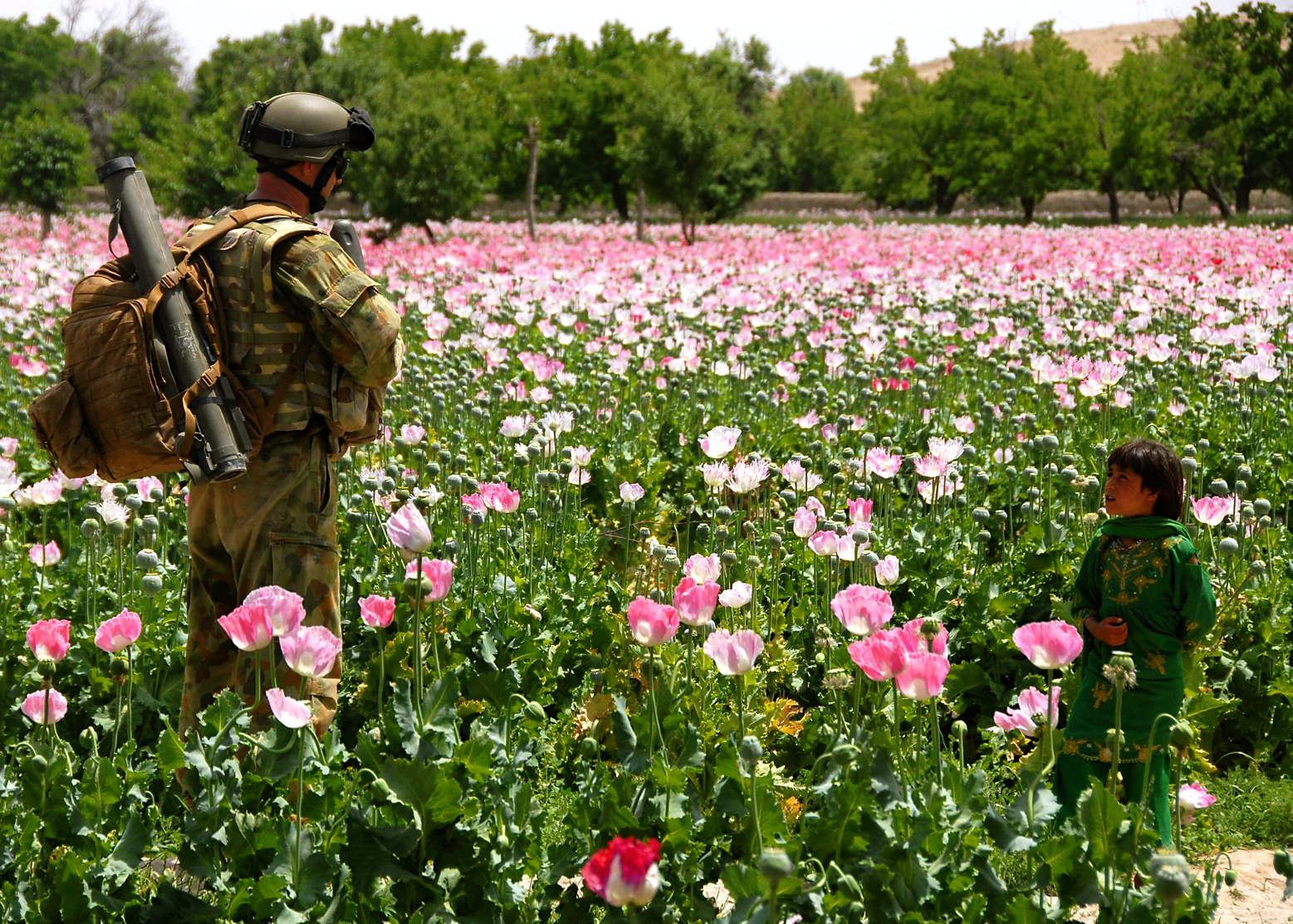This image was taken in Uruzgan Province during a patrol by Reconstruction Task Force personnel in 2008. The image depicts the thinking challenges facing our deployed commanders – the young girl is helping her family tend a poppy field and is met by a solider conducting a security patrol. It is likely her family sold poppies to the Taliban for survival which then funded weapons used by the Taliban against the soldier … and also against her family. For a period of time, poppy eradication was advocated as the solution that would break the interconnected threads of security problems stemming from the poppies. What do you think the solider is seeing at the moment when this photo was captured? Are his thoughts from the ground-up useful?
Many panaceas were advocated during Australia’s involvement in Afghanistan including the overarching counterinsurgency method of shape-clear-hold-build-transition, poppy eradication, crop replacements, security-development nexus, and empowerment of women to name a few. In isolation and on paper these solutions look viable, but what do they look like when they meet reality on the ground? Junior commanders are situated in the chain-of-command where an ‘idea’ from the strategic level becomes tangible action. Junior commander’s insight from the ground-up, as the last link before a plan becomes action, is important. But how do junior commanders communicate effectively what they see on the ground? I encourage thought to this question when you deploy – think about ways you can value-add to the communication process instead of just blindly following process.
In many regards, this photo also gives a visual of the following trends in warfare facing junior commanders: complexity, convergence and people.
Complexity. If history is an indicator of the future, our junior commanders will face operating environments characterised by complexity. Junior commanders’ actions on the ground will require consideration of second and umpteenth order effects over both the short and long term (i.e. effects longer than just their deployment cycle). Junior commanders also face making decisions where the choice is not just between right or wrong. For example is eradicating a poppy crop right or wrong? Is leaving the poppy crop right or wrong? What is the long term effect of leaving the poppy crop? What is the long term effect of eradicating the poppy crop? Decisions will likely be a shade of grey with consequences playing out beyond an individual deployment timeline. Listen to this podcast with Dave Maxwell (at about the 9 minute mark) for a discussion on complexity and the junior commander.
Convergence. The soldier in the photo is infantry – a warfighter. Yet elements from outside the traditional ‘infantry operating box’ are converging around him. This includes strategic-to-tactical convergence when looking at poppy eradication programs driven from the top-down. It also includes the convergence of tasks – he is on a security patrol but what does this mean when faced with ‘people’ in the battlespace? Having a Civil Affairs Team or CIMIC Officer has not meant that ‘people’ have been placed in an operational box for only CIMIC Officers to deal with. Roles and thinking are converging and no one person in the military team ‘owns the people problem’. Not being able to choose whether you are a warfighter or humanitarian first came to prominence through General Kruluck’s thoughts on Strategic Corporal and Three Block War. A converging environment means that junior commanders need to sense the situation on the ground with strategic perspective of the decisions being made outside his or her immediate battlefield.
People. In this podcast with David Ucko, he speaks about the conundrum of the junior commander facing the challenge of ‘Do No Harm’ but then also having a mission objective directed from higher. Ucko explains that when you interact on the ground, even in something as simple as building a well, there are always winners and losers. There are those people who will benefit from the well and those who will not. Likewise, in this example, there would be those people who benefit from poppy eradication and those people who won’t. This reality is sensed by our people on the ground – our junior soldiers and commanders. Sensors driven by technology, including drones, do not see nor can they grasp the importance of small nuances in the population. Understanding the human dynamic on the ground is an implied task, no matter the mission. In this photo, the soldier was on a security not a population support task but that did not negate the fact that ‘people’ were present in his battlespace. Whether tasked with conventional or unconventional operations, people will be an enduring trend that shapes the junior commanders’ operating environment.
From this tiny snapshot in time captured in this photo, you can see that it would be difficult to arm a junior commander with set steps from doctrine as the COA for success. Doctrine will continue to provide the foundation for our junior commanders but their thinking to nuance taught tactics for their specific operating environment will be the key. This operating environment needs junior commanders with intellect, strategic perspective and adaptability – all qualities defined and assessed in our Army Officer Performance Appraisal Report (Australian Army reporting). Whilst these are just three words on an assessment form, they are not throw-away concepts – so what can you and your team do to educate and train in these areas to become the best you can be for next conflict?


